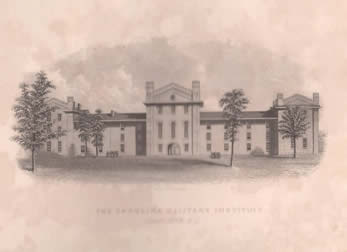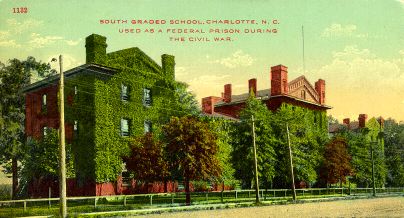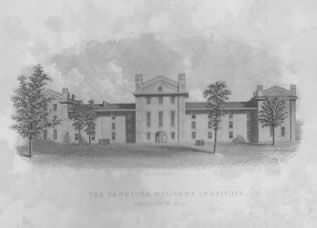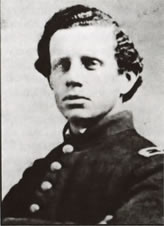North Carolina War Between the States Sesquicentennial
The North Carolina Military Institute

The North Carolina Military Institute in the War
“At the outbreak of hostilities Gen. James H. Lane was a young professor in the North Carolina
Military Institute, at Charlotte, and occupied quarters in the barracks. When Fort Sumter fell,
he was waited on by a committee from that patriotic and well-behaved corps of boys to know
if he objected to their raising a Confederate flag on the building early next morning and firing
an artillery salute as the train passed.
He replied, “Young gentlemen, I am not the superintendent. You know my habits, and I do not
expect to change my hour of rising.” To this there was a “Thank you, Lieutenant,” as those
merry-hearted fellows rushed from his room.
Next morning, long before sunrise, there was a “secesh flag” floating from the barracks, made
and presented by the ladies of the town; and when the train passed on its way to South Carolina
the artillery thundered forth its greetings. To keep these enthusiastic boys together
Governor [John W.] Ellis ordered them up to Raleigh to act as drillmasters
in the State’s first camp of instruction.
The governor had appointed the superintendent of the Institute, D.H. Hill, colonel commanding
the camp, and at Hill’s request Lane acted as its adjutant. When the first regiment of volunteers
was organized, D.H. Hill, C.C. Lee, and J.H. Lane of this military institute, were elected its field
officers, and Hill appointed Cadet Poteat his adjutant.
There were in this regiment two companies from Charlotte, the old historic “Hornet’s Nest Rifles”
and a company of gallant boys commanded by Captain Ross, known
in the regiment as Charlotte’s “Spring Chickens.”
D.H. Hill rose to the rank of lieutenant-general, and a braver man the world never saw.
At Frazier’s farm Lee and Lane, always bosom friends and then commanding the 37th and
28th North Carolina Regiments in A.P. Hill’s light division, charged a Federal battery. Lee was killed,
and Lane was severely wounded in the cheek. When [L. O’B.] Branch was killed at Sharpsburg,
Lane took charge of the brigade, and the brigade soon petitioned for his promotion
and assignment as its permanent commander.
On the recommendations of Generals [Robert E.] Lee, [“Stonewall”] Jackson, and A.P. Hill, he was
promoted and assigned to the command of Branch’s Brigade. When as lieutenant-colonel of the
Bethel Regiment, Lane left the Peninsula to take charge of the 28th North Carolina, of which he had
been unanimously elected colonel, he was presented with a sword, saddle and bridle, and a pair of
handsome silver goblets. When he was appointed brigadier, the brigade received the
announcement with cheers of delight and soon after presented him with a sword, saddle and bridle,
and an elegant general’s sash.
He took an active part in all of the great battles fought by the Army of Northern Virginia and
was wounded three times. Of him President [Jefferson] Davis said: “Endeared to me, as he is,
by his services to the South when he was the youngest brigadier in the Confederate army,
I admit that I feel a warm interest in his success, not for himself only, but also as a good
example for the youth of a State I love so well.”
Col. R.M. McKinney, of the 15th North Carolina, was another professor in the North Carolina
Military Institute. He was killed April 16, 1862, while gallantly fighting near Williamsburg, Va.
A large number of cadets of this Institute held official positions in the Army of Northern Virginia.
Of them we recall Ratchford, aid to Gen. D.H. Hill; the modest but brave Maj. J.G. Harris, of the
7th North Carolina, often in command of his regiment; the fearless boy-captain, Johnnie Young, of
the same glorious old regiment; Capt. Nick Gibbon, of Charlotte, the efficient commissary of the
28th; and the gallant and handsome Dave Oates, also of Charlotte, the adjutant of the 37th.
Lane’s was one of three brigades that constituted the rear guard of the Army of Northern Virginia whe
n it crossed the Potomac at Williamsport after the battle of Sharpsburg. At Falling Waters it stood alone,
fighting as it covered the crossing of the same river on the pontoon bridge of that part of Lee’s army
after the battle of Gettysburg.
Next morning, while on the march in a pouring rain, General [Henry] Heth rode up and, saluting Lane,
said: “This is a pleasure I did not expect yesterday. When I ordered you to cover the crossing, I was afraid
all of you would be killed or captured.”
Lane replied: “But didn’t they behave handsomely? I was proud of my brave fellows when they
crossed that wobbling bridge in the presence of the enemy in such splendid order and gave you that
fearless Rebel yell as you took off your hat to them.”
(North Carolina Institute in the War, Confederate Veteran, September 1915, pg. 400)
![]()
Origin and Growth of the North Carolina Military Institute
Organized in the late 1850’s by Charlotte businessmen led by Dr. Charles J. Fox, the cornerstone
for the building was laid in 1858, and completed the following year. The initial class enrollment
was 125 students ranging from twelve to twenty-one years old.
Educator and military officer Daniel Harvey Hill served as Superintendent of the North Carolina
Military Institute from October, 1859 to April, 1861, and he oversaw the single commencement in the short
prewar existence of the school, in July, 1860. The keynote speaker of the commencement, held at the
Presbyterian Church, was to be Thomas L. Clingman, but in his absence the address was given by
Judge James W. Osborne of Charlotte.
Orations were delivered by Cadet Houston B. Lowrie, who later fell at Sharpsburg; Cadet Graham of
Alabama; and Henry Elliot Shepherd of Fayetteville. Lowrie’s theme was a eulogy upon North Carolina,
having special reference to three of her sons, Macon, Gaston and Dobbin. The oration of Cadet Graham
was patriotic in its scope; Osborne devoted his remarks to the literature of Scotland, his principal
characters being Burns and Sir Walter Scott.
Prior to Daniel Harvey Hill’s tenure at the North Carolina Military Institute, he served as Professor
of Mathematics at Washington College (later Washington & Lee), 1849-1854, and Professor of
Mathematics at Davidson College, 1854-1859.
Hill left the Institute in April 1861 and with the rank of colonel, was assigned as commander of the
First North Carolina Regiment, later known as the “Bethel Regiment.” Many of the cadets joined this regiment.
The building served as a military hospital during war; afterward it became a female academy and then
another military school organized by Colonel John Peyre Thomas in 1873, which continued through 1882.
Col. Thomas was an 1851 graduate of The Citadel, and published a "History of the South Carolina
Military Academy, 1783-1892," the predecessor of The Citadel, in 1893. From 1883 through 1950
the Institute was utilized as a Charlotte public school and demolished in 1954 to make way for an
extension of Independence Boulevard.
A North Carolina historical marker at East Morehead Street and South Boulevard
denotes its former presence nearby.
(Source: General D.H. Hill as a Teacher and Author, Dr. H.E. Shepherd, North Carolina
Booklet, Vol. XVI, No. 4, April 1917)

1880s View of Buildings as a Public School
(The following is transcribed in full from the essay: The Carolina Military Institute, Johnstone Jones,
Our Living and Our Dead, Volume I, Number 6, Official Organ, North Carolina Branch of the
Southern Historical Society, February 1875. pp. 625-628)
The Carolina Military Institute
In the suburbs of the City of Charlotte stand the buildings of the Carolina Military Institute. These buildings
are large, commodious and substantial. They fully answer the purpose for which they were originally designed.
The main edifice is of brick. It is built in the castellated style of architecture – the style that is now almost
universally adopted for Military Academies. The appearance of the building is quite imposing, with its
towers and turrets, its parapets and battlements.
From the main tower there usually floats a blue flag. It is the banner of the Institute – an emblem of the
progress of Education in North Carolina. I wish the banners of this character floated over every town and
village in the State! It is painful to behold the educational needs of the boys and girls who are growing
up in our land. Whatever tends to supply that great want should receive the encouragement of every
patriotic citizen. The year in which Education begins to receive in North Carolina that attention which
it merits, will be a year fruitful of blessings for the State.
In these days of progress and enlightenment, ignorance and stupidity will do more to retard the growth
and development of our country than anything else. The great need of the times, with us, is educated
men for the industrial pursuits, as well as for the forum, the bar, and the pulpit. All the institutions of
learning, within our borders, should be fostered and encouraged.
The location of the Carolina Military Institute is singularly advantageous. It is an elevated site, commanding
a wide and interesting view of the city and surrounding country. The grounds are particularly attractive.
They comprise twenty-seven acres of smooth, green lawns and slopes, shaded by a beautiful grove
of oak trees. Thus, ample space is afforded for recreation, and for military and gymnastic exercises.
The location is remarkably healthful, being open to the breezes from all sides, and blessed with the
purest and most wholesome water. So much for the external appearance of the Institution, and the
advantages and beauty of its location.
The period of existence of the Institution may be measured by a few fleeting years. But however brief,
it is replete with interest. It was founded several years prior to the late war; in 1858 the corner stone
was laid; and was first known as the “North Carolina Military Institute.” I am told that the buildings
were originally planned by General Stonewall Jackson, who was then unknown to fame, and ignorant of
the glorious future that awaited him. I am further informed that Jackson then entertained an idea of uniting
with Gen. D. H. Hill, his brother in law, in the effort to establish a military school at Charlotte – one that
would rank with the academies at Lexington, Va., and Columbia and Charleston, S.C. But he finally gave
up the idea, and returned to the Virginia Military Institute where he remained until the
out breaking of the war.
The Institute was finished in 1859, and the company of citizens who owned it tendered the position
of Superintendent to Gen. D. H. Hill, who was then a professor at Davidson College. General Hill accepted
the position, and in ’59 opened the school, assisted by General Lane, Col. Charles Lee, and one or two others.

The “North Carolina Military Institute” became one of the most flourishing seats of learning in the Carolinas.
The war found it so. The war broke it up. Its brave and patriotic Superintendent was called to a high station
in the army. He was among the very first to buckle on the sword and march to the front to fight the battles
of his country. Many gallant youths whom he had trained followed him to the field.
Several efforts were made, after the close of the war, to revive the institution, but none succeeded, mainly
because of the unsettled and impoverished condition of the country. The buildings remained unoccupied
and unused most of the time until the autumn of 1873, when the “Carolina Military Institute” was
established by Colonel John P. Thomas, who had conceived the project of founding a school which would
embrace within the scope of its aims and influence the youth of both North and South Carolina.
Figuratively speaking, it was a union of the Pine and Palmetto. It was designed for both the Carolinas.
Hence the change of the name of the Institution from the “North” Carolina Military Institute to “
The Carolina” Military Institute – a name which is entirely appropriate.
That Col. Thomas met with many difficulties in the beginning of his enterprise, it is hardly necessary
to mention, as it is a well-known and very lamentable fact that educational enterprises meet with little
encouragement from the public, in this time of trouble, and distraction, and poverty and hardship. He persevered
[and] pressed boldly and unswervingly onward; overcame each obstacle in turn, and finally achieved the
object at which he aimed.
His labors have been crowned with gratifying success. The first academic year which began
October 1st, 1873, and ended October 1st, 1874, saw 102 cadets on the rolls of the Institute.
And to-day, early in the second academic year, there are 104 names on the list of boys, now
matriculated at the Institution. This exhibit indicates a remarkable degree of success. Few institutions
of learning in either of the Carolinas can boast so large an attendance during any one academic year.
The Carolina Military Institute is now established beyond peradventure. It is a permanency – fixed upon
a sure foundation, and capable of much larger growth and expansion. It has become the pride of Charlotte,
and no doubt the time will come when the people of North Carolina generally will feel an abiding
interest in its welfare and prosperity.
The object and scope of this enterprise deserves a more extended notice than I am able to give at this time,
but I will briefly allude to its salient points.
The grand primary object is to educate the cadet, mentally, morally, and physically; to develop the
body as well as the mind, and to train and cultivate the moral as well as the intellectual faculties.
So that the boy should leave the walls of the college, an able-bodied, learned and virtuous young man,
ready for the performance of all the duties of life.
The curriculum of academic studies is an admirable one. It is full and comprehensive, logical
in order, and harmonious as a whole. It is formed after the most advanced ideas regarding education,
and is a decided improvement upon the course already pursued at military institutions. The judicious
combination of the scientific and the esthetic element is especially commendable. The purely military
studies, those which relate solely to the art and science of war, are made to give way to the studies
that relate to the civil and general pursuits of life. The military element is extensively used,
but not unduly magnified; nor is it allowed to infringe upon the scholastic
and more essential exercise of the Institute.
It is formed after the most advanced ideas regarding education; and is a decided improvement upon the course
already pursued at military institutions. The judicious combination of the scientific and the esthetic element is
especially commendable. The purely military studies, those which relate solely to the art and science of war,
are made to give way to the studies that relate to the civil and general pursuits of life. This military element
is extensively used, but not unduly magnified; nor is it allowed to infringe upon the scholastic and more
essential exercise of the Institute.
The relation of the military to the scholastic features of this Institute, is best explained in the language of
the Proprietor himself. In one of his circulars, he tells us that the grand object of the discipline of the school
is “to impress upon cadets the idea of duty and responsibility. The military arm is employed not so
much to compel an unquestioning obedience to a rigid code as to strengthen appeals to the moral sense
and to enforce ethical propositions. Whilst the military power is employed, the usual appeals are made to
the moral sense and the whole discipline, though resolute, is considerate and discreet in character.”
The military feature when thus properly subordinated and regulated, is always full of excellencies, and benefits.
The studies pursued and instruction given at the Carolina Military Institute are comprised under these heads:
Mathematics, Physical Science, History, Belles Lettres and Ethics, Modern Languages, Ancient Languages,
Commercial Department, Physical and Military Department. Instruction by lectures, in all the departments,
is freely and systematically pursued.
Among the new and progressive features of the Institution are lectures upon all the matters of importance
in connection with the history and spirit of the immediate present, and upon all the questions of ethics and duties;
and also the practical illustration of the principles of Agricultural Chemistry. It is designed to have a farm in
connection with the Institute, where these illustrations may be made, and where the cultivation of the leading
products of the South may be scientifically carried out before the eyes of the cadets.
Altogether, the course of instruction is thorough, practical, and liberal in an eminent degree; and the aim
of it all is to make the graduate both polished and practical, virtuous and manly, and vigorous in both body and mind.

Col. John Peyre Thomas, the founder of the “Carolina Military Institute,” and its present Superintendent,
is a South Carolinian by birth. He was educated at the Arsenal and Citadel Academies of that State.
He afterwards was appointed Superintendent of the Arsenal Academy, a position which he filled with credit
to himself for many years. The Academy was destroyed by fire at the burning of Columbia, in 1864.
Subsequent to the war, Col. Thomas became prominent in the public affairs of South Carolina,
as an editor and a leader of the Democratic party in that unfortunate State. He distinguished himself
and won the gratitude of all true people in South Carolina by his zealous devotion to the State’s true
interests, and his bold, persistent, and unflinching exposure of the corruption of the Radical party.
The short time he was editing the “South Carolinian” Col. Thomas made a proud record for himself.
No man ever exhibited greater daring in journalism. It was not until the bankruptcy of his paper that
he ceased his efforts to redeem the fallen fortunes of his State.
Col. Thomas has been an instructor of youth since early manhood. He was always connected with
military institutions, during his career as teacher. He is a thoroughly educated man, a ripe scholar, and
an enthusiast in the cause to which he has devoted so much of his life. He is an excellent teacher,
possessing in a large degree those qualities of firmness, readiness, courtesy, sense of justice,
and aptness for imparting knowledge which are necessary in a good instructor.
He is in the prime of his life; full of the spirit and energy and enterprise, and gifted with the fine powers
of mind. He is withal an estimable gentleman and a true Christian. Col. Thomas is assisted by an able
corps of Professors – Messrs. Lynes, Cain and Hutson. They are each thoroughly qualified for the positions
which they occupy, are young men of high moral character and zealous in devotion to their profession.
Under its excellent management, the Carolina Military Institute is rapidly advancing to the front rank
of military colleges in the South. Already it takes a high stand among the educational institutions of the
country, though it has been in existence but sixteen months. Its brief career so far has been one of
remarkable prosperity, and a bright future lies before it."

Copyright 2013 North Carolina War Between the States Sesquicentennial Commission